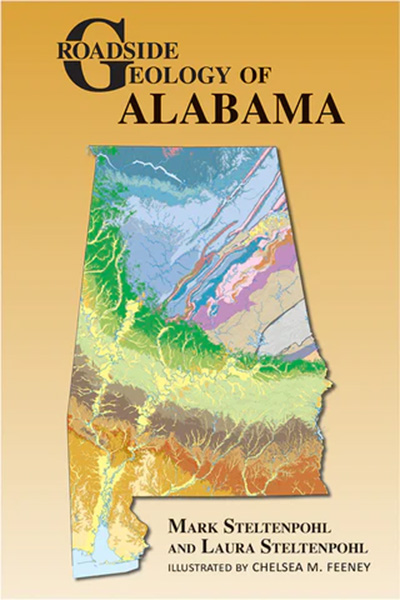By Mark Steltenpohl and Laura Steltenpohl
Illustrated by Chelsea M. Feeney
Mountain Press Publishing, 2023
Paper, $28
Reviewed by Bill Deutsch

Compared with other U.S. States, Alabama’s geology is one of the more convoluted. Its official, color-coded geology map has well over 100 different rock types on the surface, and it gets excruciatingly more complicated going deeper into the strata. Though the layer cake analogy has been used to describe the somewhat chronologically ordered layers of Alabama rock, it’s more like a cake that has been kicked around the room a few times. Making sense of it is not for the faint of heart, but fortunately, Mark and Laura Steltenpohl meticulously stepped in where angels feared to tread to make this aspect of our natural heritage accessible to the curious non-specialist.
Few are as qualified as the authors to take on this herculean task. Mark has spent more than 40 years studying the geology of Alabama as a researcher, educator, and head of Auburn University’s Geosciences Department. Laura spent two decades teaching high school Earth Science, Chemistry, and Physics and researched geochemistry of granites. Along with their expertise, Chelsea Feeney lavishly illustrated the text with colorful charts and photos. The long-awaited Roadside Geology of Alabama has finally joined a growing list of state guides published by Mountain Press.
There’s no way around it, though. Understanding Alabama’s geology is tough stuff, and grasping geological terminology borders on trying to learn Sanskrit. The general reader will probably have to make several forays into the Roadside Geology of Alabama to even begin to comprehend things, but the complexity is softened with several prescribed trips, guiding the traveler across road cuts, hills, and valleys that expose or thinly veil the underlying rock. Take the drive from Montgomery to the Florida border to traverse 60 million years of Cretaceous to Miocene deposits, including the area where “Alabama’s T-REX” dinosaur stomped around. Drive from the Tennessee line to Birmingham across 325-million-year-old limestones and sandstones to end your trip in the “Magic City” that sprang up in the late 19th century because of a fortuitous convergence of iron ore, limestone, and coal deposits. Dozens of other routes will transport you across a half-billion years of ancient seas, continental collisions, prehistoric creatures, and meteor impacts that far exceed the normal human experiences of space and time.
The reward for your persistence and repeated doses of the Roadside Geology of Alabama will be to see the state in a totally new light. You’ll gradually realize that geology is both literally and figuratively the foundation of Alabama. Rocks created our geography, soils, and river courses that strongly influenced where people settled and how they made a living. Dinosaur-age seabeds created Black Belt chalky soils that led to King Cotton and the slave trade, war and Reconstruction, Jim Crow and the Civil Rights Movement, and current reconciliations. Slowly pick your way through this book like a spelunker, pay your jargon dues, and come out with a seismically enlightened way to comprehend Alabama.
Dr. Bill Deutsch is a Research Fellow Emeritus in the Auburn University School of Fisheries, Aquaculture and Aquatic Sciences. He is the author of Alabama Rivers: A Celebration & Challenge and Ancient Life in Alabama: The Fossils, the Finders & Why It Matters (www.alabamarocksandrivers.com).





